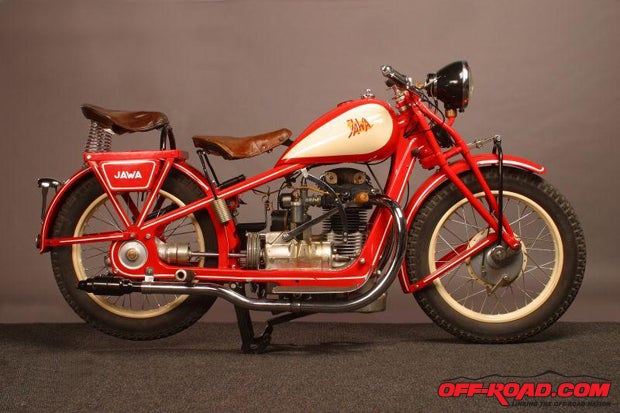
Let’s take a look at what Jawa/CZ offered back before common sense took hold of management at Jawa. The first Jawa was a four-stroke that displaced five hundred cubic centimeters and possessed an overhead valve configuration, and put out an astounding 18 horsepower!
Jawa chose to name the motorcycle the “Rump” for some reason. Perhaps there was someone with a twisted sense of humor in the design department.
The motor was placed in the frame like a BMW, drive shaft and all. It sported a three-speed gearbox, with a rigid frame, and the fire-engine red paint scheme that would be the signature color of the marque. It was also a nightmare to service, and had weak valve springs, along with slanted floorboards that tended to slip your feet onto the tarmac when the going got wet. Jawa produced the Rump for a period of six years, improving on the valve springs, the starter arrangement and the slanted floorboards.
Jawa also produced a motorcycle called the “Wanderer” that was a smaller version of the “Rump” displacing 350ccs. It was more reliable than the Rump. They sported real foot pegs that didn’t fold up; they just bolted to the frame like the ankle breakers they were.
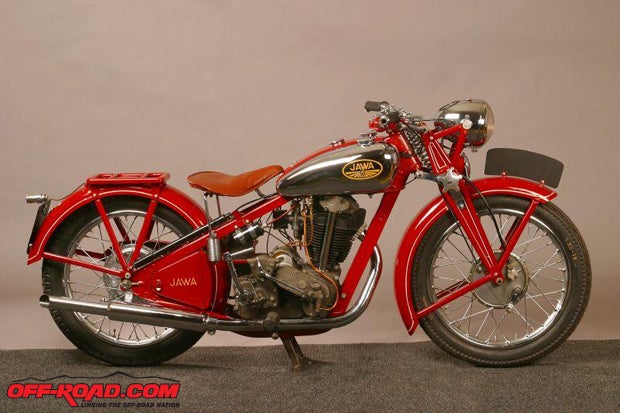
Around 1932, in the great depression, Jawa toyed with a two-stroke motorcycle that sported a Villiers 175cc motor, and was a success to some degree, since its low price fit the times when money was a hard commodity to come by.
They also started designing racing machines using again modified versions of the Rump and Wanderer motorcycles.
Jawa did make some beautiful motorcycles around that time, and perhaps the most striking was the 500cc Jawa with hydraulic forks and a plunger-type rear suspension. The motor cases were made from magnesium, along with a tower-driven overhead camshaft and four valves. The motorcycle won many club and sanctioned FIM races in the late 1940s. Look at the size of the brakes!
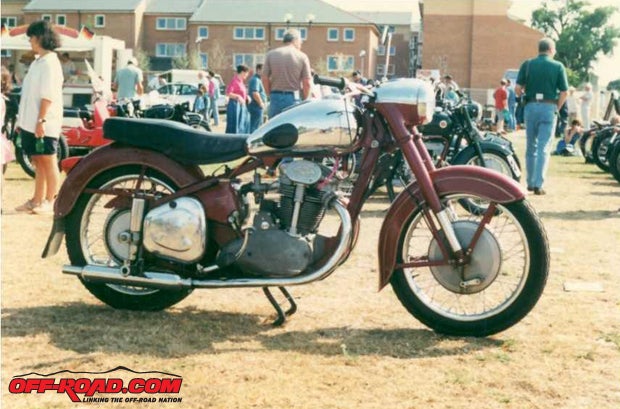
Also, Jawa seemed to have pre-dated the Japanese in engine design with bikes like the one below. It sported dual overhead camshafts, four valves per cylinder, along with an engine made almost entirely from magnesium. This is a 1955 version named the Z15 that could top out at well over 150 miles an hour.
There was another Jawa four-stroke of five hundred cubic centimeters that took design cues from the Z15, a nice looking motorcycle labeled the Type 15.
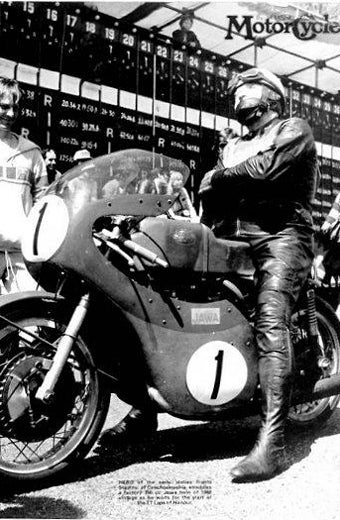
Right around this time, common sense sprung on the scene and Jawa/CZ started producing two-cycle machines that were simple to maintain, reliable and fast. Jawa four-strokes are a very wanted motorcycle in the vintage collector scene, and a good version of the “Rump” can fetch 10,000 devalued greenbacks. Quite a feat.
We’ll leave the speedway bikes out of this, since they were dominant on the racetrack for over 40 years, and were, by chance, four strokes.
So if you ever see some poor sap on a leaking, smoking Jawa four-stroke, just remember it’s most likely worth more than your house for some odd reason.
HISTORY OF JAWA/CZ
CZ is short for Ceská Zbrojovka, which is a Czechoslovakian firearms manufacturer that is also known for making CZ motorcycles. In September 1919, CZ was established as a branch of the Škoda Works Armament in Strakonice, Czechoslovakia.
CZ began making street motorcycles in 1932, but it abandoned racing them in 1972 so that they could focus on creating CZ motocross bikes. They became very well known for their powerful two-stroke MX bikes, and it was the first company to use expansion chambers in their exhaust pipes.
Although CZ was very successful in Grand Prix motorcycle racing, they were even more successful with motocross racing, winning seven World Championships and dominating the International Six Day Trials Competition.
Despite CZ’s racing success, the company lost a lot of the motorcycle market with the increase of popularity in the less expensive Japanese motorcycles in the 1970s. In 1993, Italian motorcycle manufacturer Cagiva purchased the motorcycle branch of CZ, with the intent to create new proprietary bikes as well as new CZ models. Cagiva failed in 1997 because of financial difficulties, therefore bringing an end to CZ Motorcycles.
4-STROKE CONVERSION FOR A POST-VINTAGE CZ
(Thanks to Jindrich Hruska for translating. The information appeared in a Czech site.)
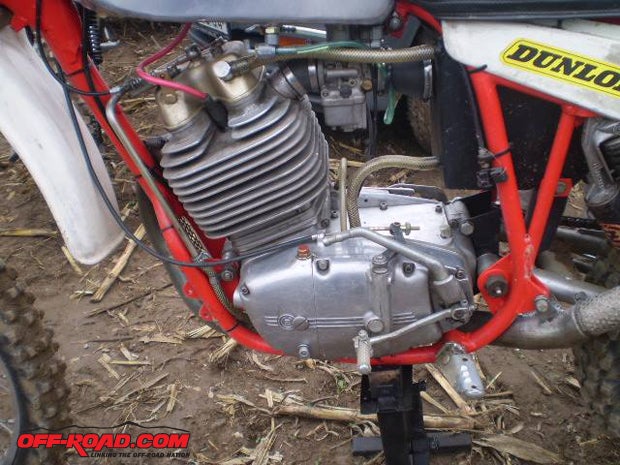
This motorcycle’s engine was built (with help from his friends), by Jiri Boubal of Jinocany Czech Republic, near Prague. He owns several CZ scramblers of different production years and displacements, but all older than 1972. (1972 is the newest vintage bike with which you can compete in vintage moto-cross in the Czech Rep.). Jiri still rides them and he wanted to have a bike in terms of his needs. So he decided to build a four stroke CZ motocrosser out of a CZ type 514, (the 1983-92 400 Motocross model).
The engine block of CZ type 514 is very compact, so the first problem, if he wanted to have a nice engine, all distribution mechanisms must be inside the original engine block. So the original ignition was removed and in its place is a gear reduction for the chain-driven camshafts. Original ignition and instead of it here is tooth gear, which is two revolutions slower of crankshaft and drives through chain distribution mechanisms in head. Oil pump use principle from Husqvarna scrambler, which have won Six-day in 1983.
In the lowest place of crankcase (where all oil streams) is a valve that opens and oil is pushed through a small oil cooler to the head. There lubricate distribution mechanisms and streams along chain of distribution down back to crankcase (the engine also has an oil filter, but they don’t write where exactly).
The engine and transmission have one oil load, which is only about 1L(0,264 US gal). The cylinder and head (four ventils) are from speedway JAWA (now are in Czech Republic two Jawa companies. First produce road bikes and isn’t in good condition, second is prospering company Jawa Divisov, which produce speedway bikes and now also some prototypes of scrambler engines - before socialization ESO scramblers and speedway bikes).
These parts were chosen because their original displacement is 500cc, and they are small and compact. But their problem is cooling, so they were made into bigger cooling ribs. CZ514 has lower upstroke, so now the displacement is 400cc. The crankshaft must been balanced for new lighter piston, piston rod is original from CZ, but have instead of needle bearing bronze bearing. Needle bearings don’t like higher forces of four-stroke engine. The original ignition was removed, so now is here only contact breaker and battery, which isn’t charged (there is no alternator), but for motocross races it is enough.
Ignition still has one disadvantage, because it doesn’t have regulation of pre-ignition (permanently 7,5mm ...5/17in). The builder of this engine must start the engine by pushing the bike in 4th gear. Once he tried to kick it and three weeks had leg in gypsum. Carburetor is Del’Orto PHF36 from a scrambler Husqvarna TE410. He tried many types, from Jikov to Mikuni, but only this fit to this engine. With it has the best power in all revolutions. At the end he writes that reliability of CZ parts - crankshaft, clutch, transmission – is very good, but distribution mechanisms from speedway bike make some problems (actually they are built not for long races, so it is acceptable). Whole engine is only about 2kg ...4.4 lb. heavier than original two-stroke and power is about 40HP.


 Your Privacy Choices
Your Privacy Choices